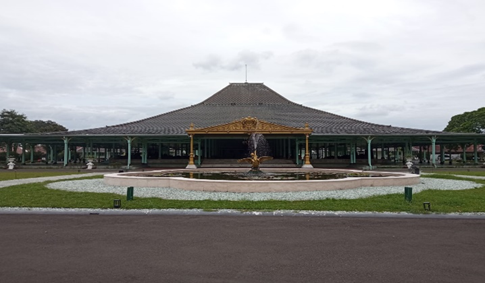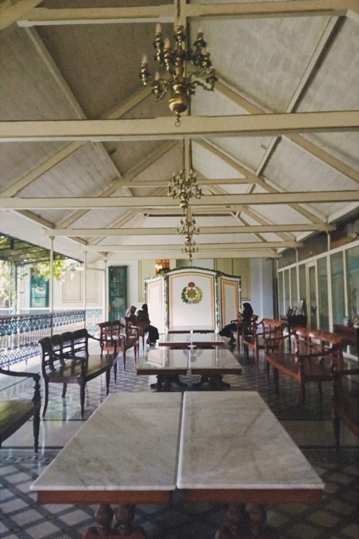PLACES IN MANGKUNEGARAN
Places in Mangkunegaran
1. Pendopo Ageng
Pendopo Ageng is one of the main buildings at Mangkunegaran Palace which was built in 1815 with a building area of almost 3000 square meters This building has a unique architectural style, built from a single teak tree sourced from the Donoloyo forest in the Wonogiri hills. This area is the largest and most extensive pavilion in Indonesia. This building is in the shape of a joglo with the dominant colors green and yellow, which are the typical colors of the Mangkunegaran family. The pavilion can accommodate between five to ten thousand people, and its floor is made of marble. Additionally, the lamps in this pavilion are imported from the Netherlands. Notably, there are four sets of gamelan in the Pendopo Ageng, namely:
- Kyai Lipursari is used every Wednesday and with dance performances.
- Kyai Kanyut Mesem is a 350-year-old gamelan that is used specifically for traditional ceremonies.
- Kyai Pamerdasih is used every Saturday.
- Kyai Udan Asih Udan Arum is used exclusively for the weddings of Mangkunegaran descendants.
Then on the ceiling of the pavilion, there is a painting with 8 colors depicting basic human nature where if we can fight against the 8 basic natures we can achieve success, the 8 colors are:
- Green: Prevents Stress
- Black: Prevents Hunger
- White: Prevents Lust
- Orange: Prevents Fear
- Pink: Prevents Satan
2. Dalem Ageng
The Dalem Ageng building has a unique pyramid shape with eight pillars in the middle. It was built in 1804 and is the oldest building in Mangkunegaran. The building is used for various events such as weddings, coronations, and circumcisions. In 1968, it was turned into a museum where many collections and discoveries from the previous Mangkunegaran era were kept. To maintain authenticity and prevent duplication by irresponsible individuals, visitors are not allowed to take pictures or videos inside the museum. Additionally, there is a central room called Krobogan/Patanen/Pasren used for offerings to Dewi Padi/Dewi Sri. The rooms on the right and left are allocated for prayers, with men praying on the right and women on the left. Other rooms on the left and right sides are reserved for the king and queen.
3. Bale Warni, Bale Peni, and Bale Kencur
In the past, Bale Warni used to be the residence of the king's daughters, while Bale Peni was designated for boys. The Bale Peni area is not allowed to enter because until now it is still used as a residence. Then behind Bale Peni, there is Bale Kencur which is a place to live for teenagers or young children. At that time, their residences were separated by gender to avoid incest.
4. Pracimayasa
Pracimayasa was built in 1920 by Thomas Karsten. The
building serves as a gathering place for the royal family and a venue to
welcome important guests. In addition, this building has a dining room which is
used for banquets.
5. Pracima Tuin
Pracima Tuin is a popular tourist destination located
within the Mangkunegaran Palace. This place offers a dining experience with a
Javanese royal atmosphere and the food menu available is tailored to Puro
Mangkunegaran. At Pracima Tuin there are two parts of the place, namely
Pracimasana which is a restaurant, and a garden which has swings under large
trees, fountains, various plants, ponds, and so on.







Komentar
Posting Komentar